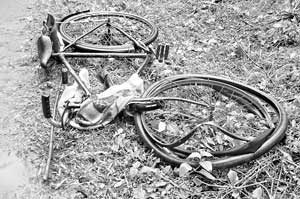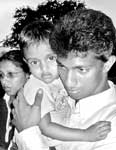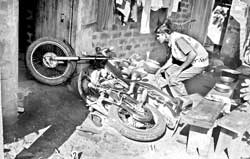Only a few are chosen as power players to mould and make political parties from behind the screen in politics. They may not be popular in politics but certainly make others popular through their skills and expertise. One such person who has been active in the Sri Lankan politics is A. M. M. Naushad, son of former Member of Parliament (MP) for Ninthavur M. I. M. Majeed and son – in – law of also former MP for Ampara M. A. Abdul Majeed. He is today the UNPA?a??a??s convener for Eastern Province and Chairman of the Eastern province Political Affairs Committee. He is also a member of the UNPA?a??a??s working committee.
Naushad who was one time a High Command member of Sri Lanka Muslim Congress (SLMC) says if the TMVP was not armed today, the UNP would have participated at tomorrowA?a??a??s election in Batticaloa. Accusing the TMVPA?a??a??s alliance with the government, Naushad told The Nation that the non participation of the UNP at tomorrowA?a??a??s election was to protest against the governmentA?a??a??s efforts to legitimise the TMVP through a working arrangement both parties have arrived at. He also declared that the UNP in the future will not align with smaller parties to contest election, but instead, added, if smaller parties desired to contest with the UNP, they should do so under the UNP symbolBy Wilson Gnanadass
Following are excerpts:
Q: How would you describe the support to the UNP by the Muslims in the East at present?
A: The UNPA?a??a??s support per se in the East among the Muslims is not something that can be quantified from what has happened since 2001. Up to the year 2000, the UNP had Muslim elected representation in Trincomalee and Batticaloa while in Ampara there was a National list MP. Thereafter with the electoral arrangements made with the SLMC, there has been no UNP organisation at electoral level, even though Ali Sahir Moulana and thereafter Myown Mustapha, were nominated on the National list. This has been due to the fact that the SLMC has always aligned with the governing party, and this has basically kept the people with them for want of political patronage. The SLMC will admit that their success at the 2001 and 2004 general elections in the East was as a result of them being able to rope in the UNP vote base.
Q: The UNP on your recommendation is not contesting the local polls scheduled for tomorrow. Why?
A: The assumption that the UNP decided not to contest in Batticaloa on my recommendation is incorrect. I as the Provincial Convener, having assessed the ground situation and the happenings in the district, was of the opinion that a free and fair election cannot be held in the Batticaloa district, with one contesting group being armed and working along with government forces. I am of the opinion that the UNP contesting at Batticaloa would only legitimise an illegal exercise. There was a lot of discussion in the party over this, and the final decision was taken by the party that it should stay out as a protest against the actions of the government.
Q: Had the TMVP contested the election unarmed conditionally, would the UNP have contested the election?
A: If the TMVP sheds its arms and enters the democratic stream of politics I would definitely be spearheading a move to work with them for the benefit of the Tamil speaking people of the area, because the TMVP comprises Tamil youth of the Eastern Province who have an important role to play in deciding our future.
Q: But the people who have been used to vote for the elephant symbol are being deprived. They say the UNP should have contested the election.
A: This decision was not taken just by the hierarchy of the party, but also on the feed back given to the party by the organisers of the district, after having consulted their supporters. In fact during the run up to the nominations, there were many reports of former UNP candidates and prominent supporters being coerced by the TMVP cadres to either contest on their list or stay away. It was a decision based on the sentiments of the people and the position of the party with regard to the activity of another wing of the LTTE in the district.
Q: Would this lead to the erosion of the UNP vote base in the East?
A: The UNP vote bank in the East has been of recent past based on the position the party faces vis a vis the national issues. The UNP is the only party that has a clear position with regard to the rights of the minorities in a negotiated settlement to the national issues. Therefore it cannot be said that decisions taken in the interest of democracy and the rights of people would erode the vote base of the UNP.
Q: What is the UNPA?a??a??s position regarding the governmentA?a??a??s plan to hold Provincial Council elections?
A: The party has just initiated discussions on this issue, and there will be a series of meetings during the course of next week with organisers of the area, after which the Political Affairs Committee of the party would take a decision.
How much atarax for anxiety Q: Do you think a Provincial Council election is necessary at present given the escalation of violence in these areas?
A: Any attempt at giving power to the people in the regions is welcome, provided a level playing field can be assured by the government in power, so that the people of the area can freely make their choice of who should govern them.
Q: The UNP is accused of involving in, A?a??E?patch work politicsA?a??a?? in the East by the SLMC. How do you view this accusation?
A: I am really amused at this accusation if there is any. Because today the SLMC is holding seats in the East only because of the UNP not nominating Muslim candidates of their own, at elections at the request of the SLMC. And in fact, the UNP not contesting the local poll in Batticaloa, is also to the advantage of the SLMC, which the SLMC will be reluctant to concede. This has actually damaged the support of the UNP. The UNP has now realised that patch work agreements with smaller parties does not help in the long run. Hence the decision to reorganise and revitalise its vote base among the minorities in the North and East.
Q: Does it mean that the future elections will be contested by the UNP without aligning with smaller parties?
A: The UNP has taken a decision that it is open to alliances with like thinking parties for an election, or for the formation of the government without surrendering its identity in the regions. This would effectively mean that any like thinking party wanting to align with the UNP would have to contest under the UNPA?a??a??s symbol, without restricting the UNPA?a??a??s need to field its own candidates as well.
Q: But is it possible under the existing electoral system to win an election without aligning with smaller parties?
A: If you go back to 1989, with the emergence of the SLMC in the East with its founder leader at the helm and at the height of its popularity, the UNP still won the Ampara and the Trincomalee districts which formed the backbone of the SLMC support at that time. So alliances with parties with a view to come into power compromising the founding principles of national parties has cost them dearly and lessons learnt are what is now the compelling factor.
Q: Has the UNP identified the needs of the people in the East and if so what are they?
A: Basically the primary need of the people in the East is peace. With peace coming in, mobility, access to their livelihood, investments in infrastructure, and maximising the resources of that area which has remained untapped for the last 30 years, would also come in automatically.
Q: What are the measures taken by the UNP to deliver this to the Muslims?
A: The UNP has very clearly in its election manifesto spelled out how it would address these issues. If you look at the manifesto of the 2005 Presidential election, 2001 and 2004 General elections the development of the East and bringing peace to the area has been given the highest priority. And once the UNP assumes power it will definitely be working on swiftly implementing its plans. But for all this to happen, honorable peace within all communities has to come.
Q: You were one time SLMC High Command Member. How do you see the performance of the SLMC now?
A: My joining the SLMC was a result of the persuasion of the Ampara district Mosque Federation that declared all Muslim political forces in the district should contest under one banner. At a meeting held at the Ranmuthu hotel subsequently, I was the first to get up and declare that I would unconditionally agree to work with the SLMC, which I was doing even at that time as a member of their Constitutional Council in an independent capacity. I was even willing to contest the election if the party requested me to do so. This was a need of the day as we had to make an effort to consolidate the Muslim voice to strengthen the communityA?a??a??s demand for independent participation at the peace process.
But this did not work out. Thereafter having joined the SLMC, I worked to ensure that the party realised the mood of the people and in keeping with reality take up positions that could eventually ensure that the community had its fair share in any negotiated settlement to the ethnic issue. Unfortunately the power politics of the current proportional representation system and the fact that the SLMC had been corrupted by power and absolute power during the 1994 to 2000 period, I realised it was difficult for the party to work towards the basic founding principles of the party. This is why the SLMC, even after having received a majority of the Muslim votes at every election, has not been able to hold on to its representatives who were elected on a mandate which is very dear to the Muslims of the North East. So the end result has been that today the party support if analysed statistically will show a very sharp decline in the North and the East. The latest episode of the SLMC deciding to join the government to save the party and thereafter leaving the government, dividing the party, proves that the party is now drifting, and unable to basically work towards maintaining its vote base among the people of the North East, who have continuously hoped that the party would deliver on its promises.
Q: Does the UNP recognise the SLMC demand for a separate administrative council for the Muslims in the East?
A: The cry for a separate council by the SLMC or for that matter Muslims of the East should be seen as a part of the whole problem because it is more a reactionary call than something that has evolved over time. The Muslims have in the history of the country never clamoured for regional power. This has come about by the non-inclusion of their aspirations by both the majority communities; that is the Sinhalese and the Tamils, though the Tamil leadership has been pointing a finger at the Sinhala majority. They have not turned that finger towards themselves and seen that they were repeating that same behaviour towards their minority, that is the Muslims of the North and East. The very same reasons attributed by them for autonomy is what is echoed by the Muslims. So this cry will not be sustained if an inclusive process evolved, which is just and equitable to all communities. The UNPA?a??a??s position is that we have to build a national identity. And it is on record that should the resolution of the North East conflict be conditional to the merger of the North and East, then the just demand of the Muslims and Sinhalese should also be met.
****
source:
http://www.nation.lk/2008/03/09/inter2.htm









 Arugam Forum
Arugam Forum Arugam Photo Galleries on Picasa
Arugam Photo Galleries on Picasa Old Website
Old Website Press Coverage
Press Coverage Surf Forecast for Arugam Bay
Surf Forecast for Arugam Bay
TODAY’s Comments